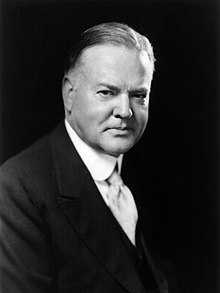📖 Presidential Profile
Comprehensive overview of leadership, policies, and historical significance
📋 Biography & Political Journey
The Great Engineer and Humanitarian
Herbert Clark Hoover brought impressive credentials to the presidency as one of America’s most accomplished **mining engineers** and international humanitarian. His relief work in Belgium during World War I and leadership of post-war European food distribution earned him global recognition as the **”Great Humanitarian.”** As Secretary of Commerce under Harding and Coolidge, Hoover promoted business efficiency and voluntary cooperation between government and industry, establishing himself as a leading advocate of what he called “American individualism.” His reputation for competence and moral leadership made him the Republican Party’s natural choice in 1928.
Economic Philosophy and Limited Government
Hoover’s presidency was built on the principle of **”rugged individualism”** and voluntary cooperation rather than direct government intervention in the economy. He believed that excessive federal involvement would undermine American character and create dangerous precedents for federal power. His approach emphasized supporting businesses and banks rather than direct relief to individuals, reflecting his conviction that prosperity would “trickle down” from business recovery. The **Reconstruction Finance Corporation** represented his major intervention, providing loans to banks and businesses while avoiding direct welfare payments.
Technological Vision and Progressive Achievements
Despite his conservative economic philosophy, Hoover was remarkably progressive on social issues and technology. He was the **first president to appear on television** and advocated for prison reform, child welfare programs, and conservation efforts. His administration began construction of the **Boulder Dam** (later renamed Hoover Dam) and other major public works projects. Hoover also took progressive stances on civil rights, inviting African American leaders to the White House and supporting anti-lynching legislation, though he struggled to balance this with Republican Party politics in the South.
The Great Depression Response Controversy
Hoover’s response to the 1929 stock market crash and subsequent economic collapse became the defining controversy of his presidency. His insistence that the crisis was temporary and his **opposition to direct federal relief** programs appeared callous to millions of unemployed Americans. The “Hoovervilles” – shanty towns of homeless people – became symbols of his administration’s perceived indifference. While Hoover did eventually support some federal intervention, including the RFC and public works spending, his reluctance to embrace more dramatic measures allowed Democrats to portray him as uncaring and out of touch with ordinary Americans’ suffering.
The White House Exercise Ball
To maintain his health and fitness, Hoover installed a **medicine ball court** on the White House grounds and organized daily games with Cabinet members and staff. These “**Hoover Ball**” sessions became legendary, with participants throwing a heavy medicine ball over a volleyball net while following tennis-like rules. Supreme Court Justice Harlan Stone was a regular player, and the games became so competitive that **Cabinet meetings were sometimes delayed because officials were too sore to sit comfortably**. The game continued even during the depths of the Great Depression, leading critics to joke that the president was “playing games while America suffered,” though Hoover maintained that physical exercise helped him think more clearly about the nation’s problems.
Humor & Jokes
Hoover's Optimism
Hoover kept saying prosperity was 'just around the corner.' Americans started joking that it must…
Read More →Greatest Wins
🏛️ Creation of the Reconstruction Finance Corporation (RFC)
Hoover's RFC pioneered federal intervention to stabilize banks and businesses during economic crisis, establishing precedent…
Read More →Epic Fails
📈 Smoot-Hawley Tariff Act
Hoover signed devastating trade legislation that worsened the Depression by triggering international tariff wars and…
Read More →